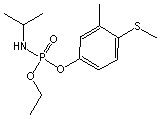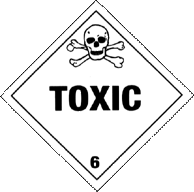Fenamiphos
- Phenamiphos
- Ethyl-3-methyl-4-(methylthio)phenyl(1-methylethyl)phosphoramidate

Fenamiphos | |
| |
| Formula | C13H22NO3PS |
| Structure |  |
| Description | Brown waxy solid or colorless solid. |
| Uses | Nematicide for use on a wide variety of field, vegetable and fruit crops. Nematicidal activity against endoparasitic, ectoparasitic, cyst forming and root knotting species |
| Registry Numbers and Inventories. | |
| CAS | 22224-92-6 |
| EC (EINECS/ELINCS) | 244-848-1 |
| EC Index Number | 015-123-00-5 |
| EC Class | Very toxic; Toxic |
| RTECS | TB3675000 |
| RTECS class | Agricultural Chemical and Pesticide; Reproductive Effector |
| UN (DOT) | 2783 |
| Merck | 12,3997 |
| Beilstein/Gmelin | 4752893 |
| EPA OPP | 100601 |
| Swiss Giftliste 1 | G-7391 |
| Austrailia AICS | Listed |
| New Zealand | Listed |
| Japan ENCS (MITI) | Listed |
| Properties. | |
| Formula | C13H22NO3PS |
| Formula mass | 303.36 |
| Melting point, °C | 49.4 |
| Vapor pressure, mmHg | 1E-6 |
| Density | 1.14 g/cm3 (20 C) |
| Solubility in water | 300 mg/L |
| Partition coefficient, pKow | 3.23 |
| Hazards and Protection. | |
| Storage | Stable under normal conditions. |
| Handling | All chemicals should be considered hazardous. Avoid direct physical contact. Use appropriate, approved safety equipment. Untrained individuals should not handle this chemical or its container. Handling should occur in a chemical fume hood. |
| Protection | Wear appropriate eye protection and protective clothing to prevent skin and eye contact. Facilities for quickly drenching the body should be provided within the immediate work area for emergency use where there is a possibility of exposure. |
| Respirators | Wear positive pressure self-contained breathing apparatus (SCBA). |
| Small spills/leaks | Caution : Explosion potential is high; containers may explode in heat of fire. Avoid sources of extreme heat. (Non-Specific -- Organophosphorus Pesticide, n.o.s.) Stay upwind; keep out of low areas. Ventilate closed spaces before entering them. Remove and isolate contaminated clothing at the site. Do not touch spilled material. Use water spray to reduce vapors. Take up small spills with sand or other noncombustible absorbent material and place in containers for later disposal. Take up small, dry spills with clean shovel and place in clean, dry container. Dike far ahead of large spills for later disposal. |
| Stability | No data. |
| Incompatibilities | May hydrolyze under alkaline conditions. |
| Fire. | ||||
| Fire fighting | (Non-Specific -- Organophosphorus Pesticide, n.o.s.) Stay upwind; keep out of low areas. Move container from fire area if you can do it without risk. Fight fire from maximum distance. Dike fire control water for later disposal; do not scatter the material. Wear positive pressure breathing apparatus and special protective clothing.(Non-Specific -- Organophosphorus Pesticide, n.o.s.) This material may burn, but does not ignite readily. For small fires, use dry chemical, carbon dioxide, water spray, or foam. For large fires, use water spray, fog, or foam. | |||
| Fire potential | Combustible material: may burn but does not ignite readily. | |||
| Hazards | Container may explode in heat of fire. Fire and runoff from fire control water may produce irritating or poisonous gases. Emits toxic fumes of nitrogen oxides, phosphorus oxides, and sulfur oxides when heated to decomposition. | |||
| Combustion products | Fire may produce irritating, corrosive and/or toxic gases. | |||
| Health. | |
| Exposure limit(s) | TLV: ppm; 0.1 mg/m3 (as TWA) (skin) (ACGIH 1996). NIOSH REL: TWA 0.1 mg/m3 skin |
| Poison_Class | 2 |
| Exposure effects | Reduced body temperature or elevated body temperature may occur. Low heart rate and abnormally low blood pressure may develop after moderate to severe poisoning. Rapid heart rate, elevated blood pressure, and changes in respiratory rate may also occur. Early giddiness, anxiety headache, and restlessness followed by ataxia, drowsiness, and confusion are common with moderate to severe exposures. Sporadic reports of human birth defects related to organophosphates have not been fully verified. |
| Ingestion | Vomiting, hypersalivation, diarrhea, fecal incontinence and abdominal pain may occur. |
| Inhalation | Dyspnea, rales, bronchorrhea, bronchospasm, or tachypnea may be noted. Noncardiogenic pulmonary edema may occur in severe cases. Chemical pneumonitis may be seen. |
| Skin | Sweating is a consistent but not universal sign. |
| Eyes | Constriction of the pupil, tearing, and blurred vision are common. Prolonged dialation of the pupils may occur in severe poisonings. Opsoclonus has been reported in one case. Salivation commonly occurs. |
First aid |
|
| Ingestion | Seek medical assistance. |
| Inhalation | Move victim to fresh air. Apply artificial respiration if victim is not breathing. Do not use mouth-to-mouth method if victim ingested or inhaled the substance; induce artificial respiration with the aid of a pocket mask equipped with a one-way valve or other proper respiratory medical device. Administer oxygen if breathing is difficult. |
| Skin | Remove and isolate contaminated clothing and shoes. Immediately flush with running water for at least 20 minutes. For minor skin contact, avoid spreading material on unaffected skin. |
| Eyes | Immediately flush with running water for at least 20 minutes. |
| Transport. | ||
| UN number | 2783 |  |
| Response guide | 152 | |
| Hazard class | 6.1 | |
| Packing Group | I; II; III | |
| USCG CHRIS Code | FNM | |